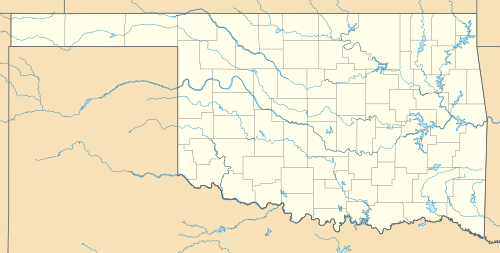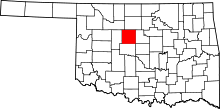Kingfisher, Oklahoma
| Kingfisher, Oklahoma | |
|---|---|
| City | |
 | |
 Kingfisher, Oklahoma Location in the state of Oklahoma | |
| Coordinates: 35°51′22″N 97°56′4″W / 35.85611°N 97.93444°WCoordinates: 35°51′22″N 97°56′4″W / 35.85611°N 97.93444°W | |
| Country | United States |
| State | Oklahoma |
| County | Kingfisher |
| Area | |
| • Total | 4.14 sq mi (10.7 km2) |
| • Land | 4.14 sq mi (10.7 km2) |
| • Water | 0.0 sq mi (0.0 km2) |
| Elevation | 1,053 ft (321 m) |
| Population (2010) | |
| • Total | 4,633 |
| • Density | 1,100/sq mi (430/km2) |
| Time zone | Central (CST) (UTC-6) |
| • Summer (DST) | CDT (UTC-5) |
| ZIP code | 73750 |
| Area code(s) | 405 |
| FIPS code | 40-39850 [1] |
| GNIS feature ID | 1094390 [2] |
| Website | kingfisher.org |
Kingfisher is a city in and the county seat of Kingfisher County, Oklahoma, United States.[3] The population was 4,633 at the 2010 census. It is the former home and namesake of Kingfisher College. According to the Encyclopedia of Oklahoma History and Culture, Kingfisher is now primarily a bedroom community for people employed in Enid and Oklahoma City.[4]
History
Kingfisher came into existence on April 22, 1889, when land owned by the federal government was opened to settlement by "land run." A huge area in what is now central Oklahoma was literally "peopled" by Americans overnight. The city is situated on a part of the Chisholm Trail, over which millions of Texas longhorns were driven to railheads in Kansas in the years immediately following the Civil War. Extension of the railroads and settlement of the open range ended this colorful era.
The town was named for an early resident who several landmarks were named for, a man named King Fisher.[5]
The bill that opened Oklahoma Territory to non-Indian settlement limited the sizes of townsites to 320 acres (130 ha). Settlers in the Kingfisher area formed two communities: Kingfisher City, on the north side of the settlement, and Lisbon, on the south side. The two merged on June 14, 1890 and the resulting town was named Kingfisher. Oklahoma Territory was organized May 2, 1890, and consisted of the Unassigned Lands and the Panhandle. The Western District included presentday Kingfisher County, part of Canadian County and the Panhandle. Abraham Jefferson Seay, a Missouri native, was appointed as District Judge and moved to Kingfisher. In 1892, Seay was appointed as the second territorial governor by President Benjamin Harrison.[4]
Economically, the Kingfisher County Development Foundation was created in 1958 for the purpose of assisting and promoting industrial, economic and civic growth within, and surrounding the Kingfisher area of Oklahoma. By better serving the needs of business development and investment, the K.C.D.F.'s pursuit of economic stability and growth has benefited its merchants, city, schools, hospital and citizens. A present K.C.D.F. strategy includes the investment for development of the Kingfisher Industrial Park. The industrial park is located just south of Kingfisher, further closing the gap between Oklahoma City and Kingfisher. Kingfisher has quickly become a suburban community of the Oklahoma City Metropolitan Statistical Area, already home to many commuters to Oklahoma City. Kingfisher is a Certified City and has received a Community Development Block Grant to inventory infrastructure features for Capital Improvement Planning (CIP).
On August 19, 2007 the City of Kingfisher was 25% flooded when Kingfisher Creek and Uncle John Creek overflowed their banks, the result of heavy rain from Tropical Depression Erin. One woman died in the flood.[6]
The Coleman Company was founded in Kingfisher by W. C. Coleman in 1900.
Geography
Kingfisher is located at 35°51′22″N 97°56′04″W / 35.856216°N 97.934517°W.[7] It is 45 miles (72 km) northwest of Oklahoma City.[4] According to the United States Census Bureau, the city has a total area of 4.1 square miles (11 km2), all of it land.
Climate
| Climate data for Kingfisher, Oklahoma | |||||||||||||
|---|---|---|---|---|---|---|---|---|---|---|---|---|---|
| Month | Jan | Feb | Mar | Apr | May | Jun | Jul | Aug | Sep | Oct | Nov | Dec | Year |
| Record high °F (°C) | 85 (29) |
93 (34) |
100 (38) |
103 (39) |
105 (41) |
113 (45) |
115 (46) |
118 (48) |
110 (43) |
101 (38) |
90 (32) |
88 (31) |
118 (48) |
| Average high °F (°C) | 47.4 (8.6) |
53.8 (12.1) |
63.3 (17.4) |
72.4 (22.4) |
80.5 (26.9) |
89.5 (31.9) |
95.2 (35.1) |
94.3 (34.6) |
85.8 (29.9) |
74.9 (23.8) |
60.0 (15.6) |
49.9 (9.9) |
72.4 (22.4) |
| Average low °F (°C) | 24.5 (−4.2) |
29.4 (−1.4) |
37.8 (3.2) |
46.7 (8.2) |
56.7 (13.7) |
65.8 (18.8) |
70.5 (21.4) |
69.2 (20.7) |
61.4 (16.3) |
49.7 (9.8) |
37.1 (2.8) |
27.8 (−2.3) |
48.2 (9) |
| Record low °F (°C) | −16 (−27) |
−20 (−29) |
−3 (−19) |
15 (−9) |
28 (−2) |
45 (7) |
51 (11) |
44 (7) |
29 (−2) |
12 (−11) |
6 (−14) |
−14 (−26) |
−20 (−29) |
| Average precipitation inches (mm) | 1.14 (29) |
1.51 (38.4) |
2.66 (67.6) |
3.23 (82) |
5.01 (127.3) |
4.32 (109.7) |
2.22 (56.4) |
2.75 (69.9) |
3.53 (89.7) |
2.57 (65.3) |
2.38 (60.5) |
1.63 (41.4) |
32.95 (836.9) |
| Average snowfall inches (cm) | 1.8 (4.6) |
0.7 (1.8) |
0.1 (0.3) |
0 (0) |
0 (0) |
0 (0) |
0 (0) |
0 (0) |
0 (0) |
0 (0) |
0.3 (0.8) |
1.1 (2.8) |
4.1 (10.4) |
| Average relative humidity (%) | 72 | 70 | 71 | 69 | 73 | 69 | 60 | 60 | 65 | 69 | 73 | 75 | 69 |
| Source: Oklahoma Climatological Survey [8] | |||||||||||||
Demographics
| Historical population | |||
|---|---|---|---|
| Census | Pop. | %± | |
| 1890 | 1,134 | — | |
| 1900 | 2,301 | 102.9% | |
| 1910 | 2,538 | 10.3% | |
| 1920 | 2,446 | −3.6% | |
| 1930 | 2,726 | 11.4% | |
| 1940 | 3,352 | 23.0% | |
| 1950 | 3,345 | −0.2% | |
| 1960 | 3,249 | −2.9% | |
| 1970 | 4,042 | 24.4% | |
| 1980 | 4,245 | 5.0% | |
| 1990 | 4,095 | −3.5% | |
| 2000 | 4,380 | 7.0% | |
| 2010 | 4,633 | 5.8% | |
| Est. 2016 | 4,888 | [9] | 5.5% |
As of the census of 2010, there were 4,633 people, 1,804 households, and 1,217 families residing in the city.[11] The racial makeup of the city was 83.9% White, 1.6% African American, 3.8% Native American, 0.5% Asian, 6.9% from other races, and 3.3% from two or more races. Hispanic or Latino of any race were 12.4% of the population.[11]
There were 1,804 households out of which 28.4% had children under the age of 18 living with them, 51.5% were married couples living together, 10.6% had a female householder with no husband present, and 32.5% were non-families while 29.2% of all households were made up of individuals.[11] The average household size was 2.5 and the average family size was 3.06. The median age was 37 years. 52.1% of the population was female and 47.9% male.[11]
As of the 2013 American Community Survey, the median income for a household in the city was $49,727, and the median income for a family was $59,408.[12] Males had a median full-time income of $49,444 versus $32,996 for females.[12] The per capita income for the city was $24,363.[12] About 7.7% of families and 5.8% of the population were below the poverty line, including 7.9% of those under age 18 and 9.6% of those age 65 or over.[12]
Places of interest
Kingfisher's main permanent tourist attractions are the Chisholm Trail Museum, and the Gov. Seay Mansion nearby. These facilities preserve relics and information of the community's unique heritage.
Government
Kingfisher has a commission-manager government.[4]
Notable people
- Don Blanding, poet
- Sol Butler, pioneering black Olympian and 1920s NFL player
- Curtis Lofton, NFL linebacker for the Oakland Raiders
- Joe Redington, founder of the Iditarod Sled Dog Race
- James "Bud" Walton, co-founder of Wal-Mart
- Sam Walton, founder of Wal-Mart
- Raymond A. Young, one of three co-founders of T G &Y Stores.[13]
References
- ↑ "American FactFinder". United States Census Bureau. Retrieved 2008-01-31.
- ↑ "US Board on Geographic Names". United States Geological Survey. 2007-10-25. Retrieved 2008-01-31.
- ↑ "Find a County". National Association of Counties. Archived from the original on 2011-05-31. Retrieved 2011-06-07.
- 1 2 3 4 McIntyre, Glen. Encyclopedia of Oklahoma History and Culture. "Kingfisher." Retrieved March 6, 2015.
- ↑ Alley, John. City Beginnings in Oklahoma Territory. University of Oklahoma Press, Norman, Oklahoma, 1939.
- ↑ KWTV August 19, 2007
- ↑ "US Gazetteer files: 2010, 2000, and 1990". United States Census Bureau. 2011-02-12. Retrieved 2011-04-23.
- ↑ "The Climate of Kingfisher County" (PDF).
- ↑ "Annual Estimates of the Resident Population for Incorporated Places: April 1, 2010 to July 1, 2016". Archived from the original on June 2, 2017. Retrieved July 4, 2017.
- ↑ "Census of Population and Housing". Census.gov. Archived from the original on May 12, 2015. Retrieved June 4, 2015.
- 1 2 3 4 DP-1 Profile of General Population and Housing Characteristics: 2010--2010 Demographic Profile Data United States Census Bureau, retrieved April 27, 2015.
- 1 2 3 4 DP03 Selected Economic Characteristics: 2009-2013 American Community Survey 5-Year Estimates, United States Census Bureau, retrieved April 27, 2015.
- ↑ Wilson, Linda D. "T.G.&Y. Stores." Encyclopedia of Oklahoma History and Culture. Accessed August 2, 2017.
External links
| Wikimedia Commons has media related to Kingfisher, Oklahoma. |
- Kingfisher Chamber of Commerce
- Oklahoma Digital Maps: Digital Collections of Oklahoma and Indian Territory
